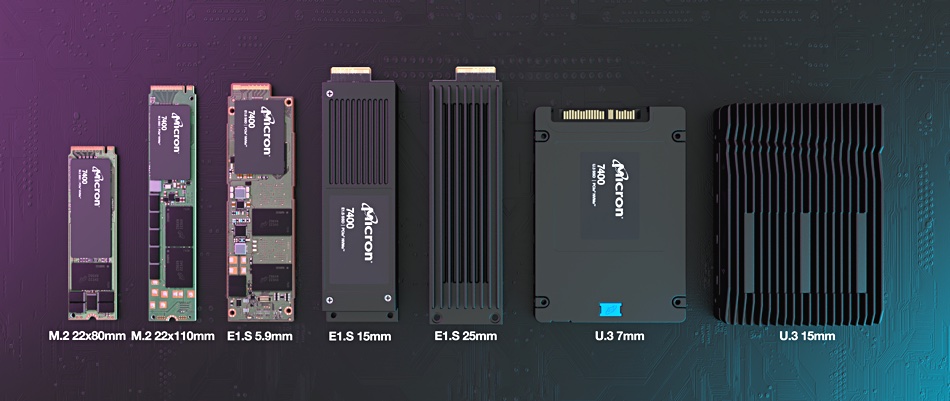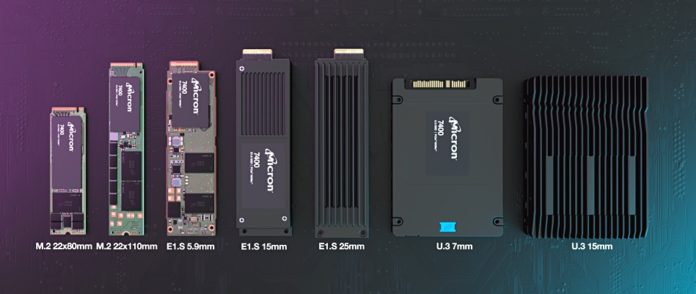Micron is launching a PCIe Gen-4 enterprise-class NVMe SSD with ruler formats as it stakes a claim for greater datacentre SSD market share, but it’s using the same old 96-layer 3D NAND as the prior 7300 NVMe SSD, which was based on PCIe Gen-3.
The earlier 7300 SSD was a TLC (3bits/cell) drive which came in PRO (1 drive write per day) and MAX (3 DWPD) versions, both packaged in M.2 (gumstick) and 2.5-inch (U.2) form factors. The newer 7400 sticks with the PRO and MAX variants, but there are now seven form factors in total: M.2 2280 in 80mm and 110mm lengths, U.3 2.5-inch 7mm and 15mm thick, and three sizes of E1.S (short ruler or large gumstick). The E1.S ruler is designed to take over from the M.2 format.
Jeremy Werner, Corporate VP and GM of Micron’s Storage BU, issued the announcement quote: “Our customers need improved storage density and efficiency to run their businesses. The Micron 7400 SSD is flexible in its ability to address myriad applications and system interoperability requirements, enabling deployments and delivering value from edge to cloud.”

They don’t get any improved density from denser NAND; Micron is already shipping far denser 176-layer product than the legacy 96-layer stuff. For example the 2450 and 3400 notebook and desktop/workstation PCIe Gen-4 drives in M.2 format, which were announced just four months ago. The 7400 customers will get improved density from the E1.S format drives, more of which can be packed into a server chassis than the M.2 product.
7400 and 7300 capacities in the M.2 and 2.5-inch form factors are identical except in the MAX products. There, the 7300 MAX M.2 capacities are 400GB and 800GB while the 7400 MAX M.2 has these capacities plus 1.6TB and 3.2TB. A table provides the full capacity points and maximum performance numbers:

PCIe Gen-4 helps give the 7400 a significant speed boost over the PCIe Gen-3 7300, as a glance at the following table will show:

The 7400 outperforms the PCIe Gen-4 2450, but only just surpasses the 3400 which maxes out at 720,000/700,000 random read/write IOPS and 6.6/5.0 sequential read/write GB/sec bandwidth. Micron’s 7400 PRO U.3 pumps out 1,000,000/400,000 random read/write IOPS and 6.6/5.4 sequential read/write GB/sec bandwidth. The 7400 puts out more random read IOPS but fewer write IOPS than the 3400 and has more sequential write bandwidth.
Controller security features are enhanced compared to the 7300, as the 7400 comes armed with TCG-Opal 2.01 and IEEE-1667, Firmware Activate without Reset, Power Loss Protection, Enterprise Data Path Protection, Secure Erase, Secure Boot, Hardware Root of Trust and Secure Signed Firmware.
The 7400 controller features support for 128 namespaces to increase scalability for software environments, and also supports Open Compute Project (OCP) deployments.
Check out Micron’s 7400 web pages to find a product brief and other documentation.
The contenders
In the PCIe Gen-4 arena, Samsung has its PM9A3 — an E1.S format drive which complies with the OCP specification. Its capacities range from 960GB to 7.68TB — virtually the same as Micron’s 7400. Kioxia’s CM6 and CD6 client SSDs in U.3 format outperform Micron’s 7400. Liqid’s LQD4500 Honey Badger SSD simply blows the Micron drive out of the park performance-wise, with its four million random IOPS, but it does use 16 lanes instead of the 7400’s four.
SK Hynix is sampling two PCIe 4.0 drives: the 96-layer TLC flash PE8010 and PE8030, both in U.2 format. It is also prepping the 128-layer TLC PE8111 in EDSFF long format. Provisional performance numbers show similar numbers to the 7400.
Micron may well have an edge because of its form factor range (M.2, U.3 and E1.S) and its security features.








